Kettlebell Deadlift
by Sam Franklin
How to Master The Kettlebell Deadlift: The Lower Body Big Hitter
As one of the most effective and efficient lower body strengtheners out there, the kettlebell deadlift is an exercise that boasts big gains for those willing to commit.
While it looks simple enough, getting it right requires a little more form and finesse than you might think.
But, don’t sweat it because we’re here to tell you all about kettlebell deadlifts with our handy guide.
Let’s go.
How to do a kettlebell deadlift: video tutorial
Before we dive into the benefits of kettlebell deadlift, watch our quick tutorial video by Luke Baden, Kettlebell Master Trainer.
Luke will take you step by step through the entire movement, ensuring your form is correct and you get the absolute maximum out of the exercise.
Step by Step Guide to the Kettlebell Deadlift
Step 1: The Kettlebell Deadlift
One of the best exercises to start with your new kettlebell. Place the kettlebell in the centre of the mat. For the first set-up, start by lining up the malleolus, the inside of the ankle, with the horns of the kettlebell.
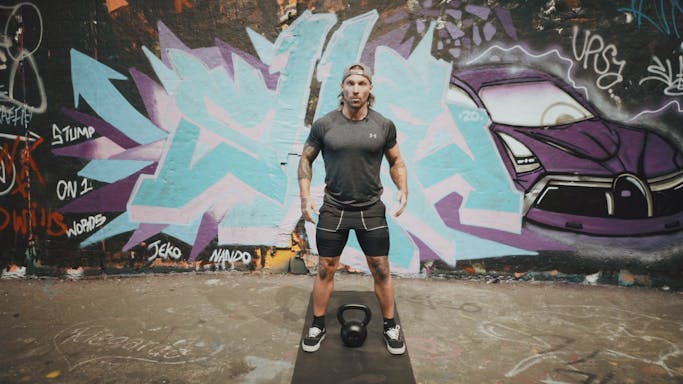
Step 2: The Kettlebell Deadlift
From there, push your little fingers into your hip crease and push back to find your hip hinge.
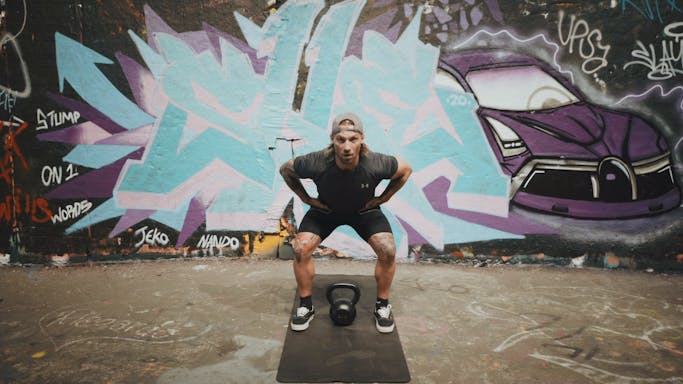
Step 3: The Kettlebell Deadlift
Now you are ready to put your hands on the bell. Grab hold of the horns of the bell, but don't lift it yet. First, you need to pack the shoulders, so squeeze your shoulder blades back and down.
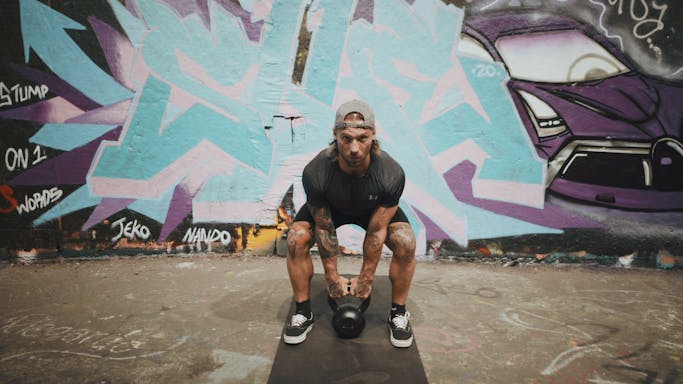
Step 4: The Kettlebell Deadlift
Now you are ready to lift! To lift the kettlebell, hold your abs firm and push the floor away with your legs. Stand tall and make sure you don't lean back.
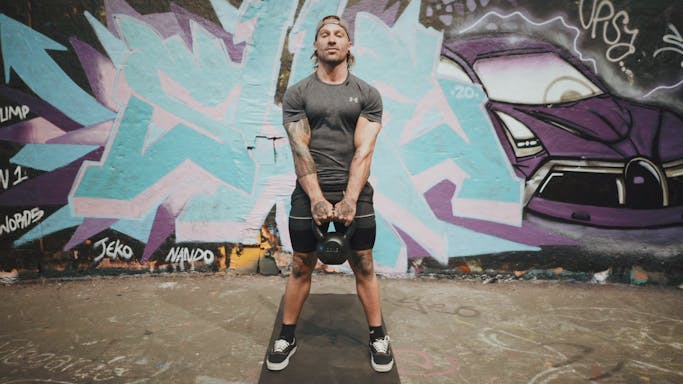
Step 5: The Kettlebell Deadlift
Guide the kettlebell back to the start position. Drive up, push the floor away, then guide the kettlebell back down. Repeat. Every rep, pack the shoulders and stand tall.
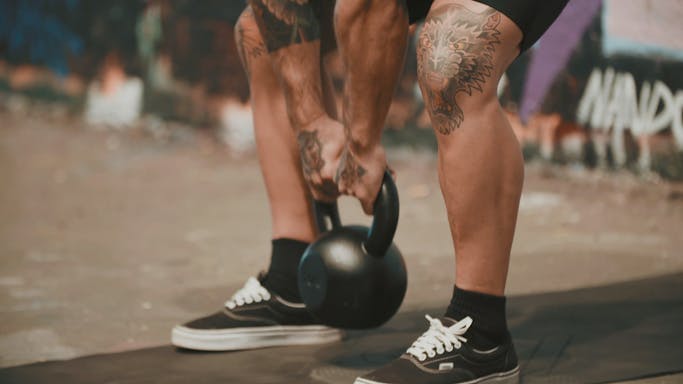
The body-boosting benefits of kettlebell deadlifts
As one of the world’s most beneficial kettlebell exercises, the deadlift targets all the main muscle groups at the backside of the lower body. Let’s take a look at it’s most body-boosting benefits:
- Activation: The kettlebell deadlift's dynamic movement pattern engages major muscle groups throughout the body, particularly in the legs and buttocks. In doing so, this most essential of exercises activates and stimulates the muscles, offering bundles of calorie burning and conditioning benefits.
- Posture: As you lift from the floor, generating power from your glutes and hamstrings, the kettlebell deadlift strengthens the core while promoting solid posture—which is essential to general health and wellbeing.
- Weight: If you’re looking to lose weight and burn fat, the kettlebell deadlift is your friend. By moving the kettlebell from a low, static position, you will use maximum muscle energy with each lift, burning more fat in the process.
What muscle groups do the kettlebell deadlifts work?
The big-hitting nature of the kettlebell deadlift makes it an incredibly effective movement for optimising lower body muscle function. Here are the main muscle groups the deadlift targets:
- Hamstrings: Leg muscles that assist overall lower body robustness, flexibility, and knee strength.
- Glutes: Also known as the bum or buttock muscles, strong glutes will give your body extra stability and agility.
- Adductors: Located near the lower thigh, this vital group of muscles provides support to the femur and hip joint. Adductors essentially bring the thighs together, so strengthening them will make you fitter and less susceptible to injury.
- Erector spinae: A collective of muscles and tendons that run alongside the spine, taking care of your erector spinae region will make your core stronger, more flexible, and protect the structure of your back. Excellent for everyday resilience and posture.
Kettlebell deadlift form tips
What to do
We’ve covered the body-enhancing perks of the kettlebell deadlift—now we’re going to help you get the most from your workout by offering essential tips to improve your form.
- Hip positioning: With your feet pointing forward and roughly shoulder-width apart, push your hips backwards to achieve a straight, flat back.
- Weight distribution: Before performing the movement, make sure that you place your body weight on your heels while angling your chest slightly upwards to ensure perfect pre-lift form.
- Arm posture: Remaining in position, lower yourself to the kettlebell between your legs with straight arms, making sure they’re positioned between your legs.
- Lift form: Once you’ve engaged the kettlebell, pause for a moment before squeezing your buttocks, driving your hips forward and using your lower body to stand tall in one smooth, swift movement. Lower yourself, maintaining position, keeping hold of the kettlebell—and repeat.
- Kettlebell size: It’s vital to choose your kettlebell weight according to your size, strength, and fitness level. If you’re a beginner, a 12kg kettlebell may be the most suitable, but if you have a little strength training experience, 16kg or 20kg options will be more effective.
What to avoid
While the kettlebell deadlift offers a wealth of health benefits, if you get it wrong you can injure yourself. To prevent pulling a muscle or suffering from a bad back, here are the things you should avoid at all costs:
- Don’t lift with your lower back or move it too much when you’re lifting or you will suffer from pain and injury, either immediately or over time.
- Don’t bend or round your back when you’re lifting the kettlebell from the floor position. Keep your back flat at all times.
- Don’t lean too far back when deadlift. Yes, you must place your weight on your heels but avoid overcompensating or you will force your back to do the work, rather than your lower body.
- Don’t get too complacent when picking up or putting down your kettlebell. Always aim to bend your knees and keep your back niche and straight.
Related kettlebell deadlift exercises
Last but certainly not least, if you want to supercharge your kettlebell deadlift workout, here are some relevant exercises you should consider:
Kettlebelle Deadlift video transcript
This is an instructional video for the kettlebell deadlift and it’s probably where you should start with your new kettlebell.
So, first thing is really important, to set up properly. Your set up is your first rep.
So what I want you to think about is approaching the bell, lining up the malleolus, which is the ankle bone, with the horns of the bell. So lining up malleolus. That’s your first marker.
From there, little fingers pushed into the hip crease and push your hip crease back to find you hip hinge.
From there you’re ready to put your hands on the bell. Grab the horns but don’t lift it.
Most important part now is to pack the shoulder so squeeze shoulder blades back and down.
Now we’re ready to lift. Hold your abs strong and push the floor away with your legs.
On the way back down, guide the kettlebell back to the start position.
Drive up, push floor away, and then guide kettlebell back.
Every rep, pack the shoulders. Every rep stand tall. You don’t need to lean back.
Pack shoulders. Stand tall. Guide kettlebell back.
Pack shoulders. Stand tall. Guide kettlebell back.
So that’s a video for kettlebell deadlift.